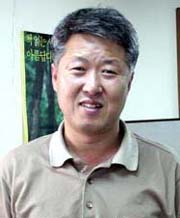Saigon, April 1975. Most of South Vietnam had fallen to the forces of
North Vietnam and the National Liberation Front (also known as the "Vietcong").
Everyone--from the president to those making a living near U.S. bases--
followed the retreating American military in the hope of saving
their own life. President Thieu entrusted his position to Vice
President Tran Van Huong on the 21st and fled the country. Five days
later, President Huong followed in his predecessor's footsteps.
On the 29th, the day before Saigon fell, the enemy advanced all the
way up to the threshold of the American embassy. Pandemonium broke out
as people clung to the Embassy's iron fence, others jumped over it
only to be chased back out, and yet others became entangled in the
ladder of the evacuation helicopter hovering above. From this landscape of fear,
the scene of the last departing helicopter was adopted in the "Free World" as the
symbol of the Vietnam War's "tragic ending."
Fifteen years later, this scene was reborn in a musical by an English
producer and a French composer, whose country had occupied Vietnam for
some 80 years. The hearts of the audience were swept away in the
whirlwind, roar and overpowering authenticity of the scene as the
three-quarter-scale helicopter took off onstage live. The figure of Mr. America
(Chris) anxiously awaiting Miss Saigon (Kim) brought tears to the
spectators of the Free World. The name of the play was Miss Saigon.
Since debuting in London in 1989, the play has moved some 31,000,000
people through more than 19,000 openings in 240 cities across 23
countries. It was chosen alongside "The Phantom of the Opera," "Les
Miserables" and "Cats" as one of the four big musicals. With its
premier in Korea scheduled for the end of June, it is making waves
inside and outside of the entertainment world. Judging by the level of
advanced purchases made over Ticketlink, it has already risen to the
third most popular play domestically, even with another two and a half
months to go until its premier. This is quite a feat, indeed.
Love springing up amid the tragedy of war, set to the play’s dramatic score,
still plucks the audience’s heartstrings to this day.
However, in depicting the "Vietcong" as the devil and America as the
angel of salvation, the play tramples viciously on the reality of the
Vietnam War. Pursuing its hegemonic interests in Indochina, the
American military fired twice as many bullets as were fired in the Second World
War, and dropped 1.5 times as many bombs as were dropped in fighting in the Pacific.
They turned the jungle into a sea of fire through the use of napalm,
and deformed both man and nature through the use of Agent Orange. They
killed some 1,100,000 members of the North Vietnamese Army and the
National Liberation Front, and sacrificed the lives of more than
500,000 civilians. It is for this reason that 'Miss Saigon,' who
departed together with the American troops, is viewed only as a symbol
of shame for the people of Vietnam.
Last April, 31 years after the fall of Saigon, the Chosun Ilbo
Newspaper printed a report titled, "Women of Vietnam, Onward to
the Land of Hope, Korea." A related picture bore the caption, "Korean
Princes, Please Take Us to Korea." The article brought back memories
of Miss Saigon, clamoring to flee alongside the U.S. troops three
decades ago. This story lay within the pages of the publication that claims to
be the elite newspaper of South Korea - the country that deployed some
310,000 soldiers for eight years in Vietnam, the country that killed
more than 40,000 fighters of the National Liberation Front, the
country that slaughtered 5,000 - 20,000 civilians and reduced thousands
of villages to ashes.
Since then, Saigon has been rechristened Ho Chi Minh City, and Miss
Saigon has vanished. In her place, Miss Ho Chi Minh has arisen amongst
war and its ruins to construct a new fatherland. Miss Ho Chi Minh was
the unyielding fighter who engaged in combat for 80 years with the
occupying French military, who for 10 years rebelled against the
American and South Korean military, and who bore the next generation
of fighters. It is this woman whom we must remember -- not the
fabricated image of Miss Saigon.
(I would like to express my heartfelt thanks to Le Hoang, Managing Editor of the Tuoi Tre(meaning youth) Newspaper, who taught me, through his article submitted
to the Hankyoreh, of the truth and weight of conscience
regarding this matter.)

